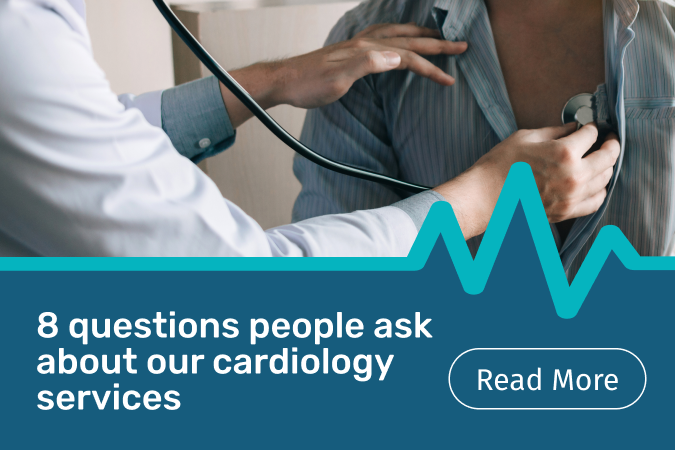
Cardiology Service
We perform a range of cardiac procedures thanks to more than 16 cardiologists treating their patients here. Yet it’s not just the number and complexity of surgeries that make us the heart of cardiac health care - the equipment and technology are state of the art.
We provide comprehensive and integrated cardiology care incorporating diagnostic, therapeutic and procedural services in our leading edge catheter lab and hybrid theatre. All our cardiac services are supported by our intensive care unit.
The private experience
Expect better when you’re with us. Your private patient comfort includes:
- Specialist of your choice
- Accommodation mainly in single rooms with ensuite
- Private dining menu
Next steps
If your GP has recommended more complex cardiac care, ask for a referral to one of the state’s leading specialists. Tell them that you prefer to be treated at Sydney Southwest Private Hospital, the heart of cardiac care.
Our world class cardiologists treat a range of heart conditions and related symptoms.
If you are experiencing any of the symptoms listed below:
- Chest pain/Angina
- Palpitations- racing or irregular heartbeat.
- Shortness of Breath
- Dizziness or fainting
- Signs of heart failure – swollen ankles, unable to lie flat or waking short of breath
You should contact your GP or present to our emergency department for assessment. If you require urgent attention dial 000 (triple zero) and ask for an Ambulance.
Procedures we offer:
Coronary angiography is the process of taking images of the coronary “heart” arteries by passing a thin tube called a catheter through an arm and leg artery to the top of the heart. A small amount of contrast is injected and an x-ray camera outside the body takes images.
Coronary angioplasty and stenting are procedures to reopen blocked or significantly narrowed coronary arteries. This may involve inflating a balloon or placing a stent (an expandable metal scaffold) into the artery to restore blood flow.
Angiography and stenting are commonly performed under local anaesthetic and IV sedation without the need for a general anaesthetic.
A pacemaker is a small device usually inserted under the skin of the upper chest and attached to a pacing wire that paces your heart when your heart is unable to do so adequately. This procedure is commonly performed under local anaesthetic without the need for a general anaesthetic.
Electrophysiology (EP) studies, are a series of tests that examine your heart's electrical activity. They involve mapping the electrical paths in the heart to determine if significant electrical abnormalities exist. This may be carried out prior to considering the best management for heart arrhythmias.
Cardiac ablation using either radiofrequency or cryo-ablation techniques to create tiny scars in your heart to block abnormal electrical signals that cause rhythm disturbances. This procedure is used to correct heart rhythm problems such as atrial fibrillation.
DC cardioversion (DCCV) is used to treat irregular heart rhythms - commonly atrial fibrillation. The procedure involves a general anaesthetic and placement of electrodes on the chest. An electrical impulse or shock is delivered to return the heart rhythm to normal.
A transesophageal echocardiogram is a type of echocardiogram (heart ultrasound) that takes images from behind the heart. This is achieved by passing the probe down the back of the throat (very similar to an endoscopy or gastroscopy procedure). The images obtained are of better quality than a normal echocardiogram due to the lack of lung (air) between echo probe and heart.
An implantable loop recorder is a convenient and easy way to obtain long term ECG recording by implanting a tiny paperclip sized device under the skin. This device can record ECGs for 3 plus years and is generally suited for patients with unexplained fainting and strokes/ministrokes of unknown cause. Your doctor can remotely monitor your heart rhythm via a mobile link that you keep in your home.
PFO is a flap like hole between the left and right atriums in the heart that is required when in the womb and normally closes after birth. In some cases, this does not close allowing blood clots to flow in the wrong direction and potentially causing a stroke, heart attack and migraines. ASD is similar to PFO but is a structurally abnormal congenital defect. These generally can be closed with a minimally invasive procedure.
CRT therapy means you will have a pacemaker, or defibrillator, placed under your skin by minor surgery. Wires from the device are connected to the ventricles on both sides of your heart. The CRT device sends electrical signals to the ventricles to make them pump together the way they should. If your condition requires a defibrillator this device will also be able to treat arrhythmias with an electrical shock.
A non-surgical procedure that uses a catheter (a thin flexible tube) to place a small structure called a stent to open up blood vessels in the heart that have been narrowed by plaque buildup, a condition known as atherosclerosis.



